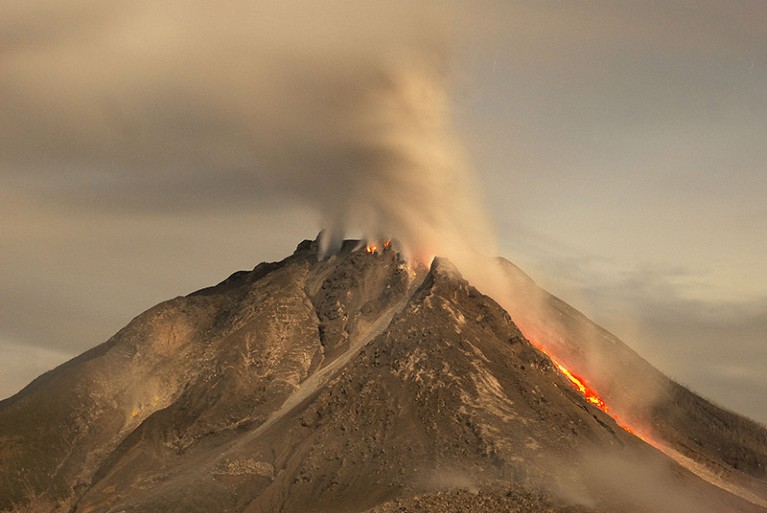
Volcanic eruptions release some carbon from Earth’s mantle, but much remains below.Credit: Sabirin Manurung/Pacific Press/LightRocket via Getty
Symphony in C: Carbon and the Evolution of (Almost) Everything Robert M. Hazen W. W. Norton (2019)
As Robert Hazen tells us more than once in Symphony in C, most of Earth’s carbon is inside the planet. Nothing remarkable there — most of Earth is ‘inside the planet’, just as most of an orange is inside the orange. But Hazen, a mineralogist and astrobiologist, is right to emphasize this in his all-encompassing survey of the element in nature. The carbon cycle we usually learn about, first described by Enlightenment scientists Joseph Priestley, Antoine Lavoisier and Humphry Davy (although you won’t find that information here), seems to take place mostly on Earth’s surface.
Once we accept that the carbon cycle involves rocks as well as water, air and living things, we vastly extend its time dimension. Carbon-rich rocks, such as limestones, are sucked inside Earth at plate margins. Some of what goes down comes back up through volcanoes. But how much stays below, to be added to the carbon in the slowly churning mantle? And what about the carbon in the nickel–iron core?
Hazen is the executive director and motivating force behind the Deep Carbon Observatory (DCO), a ten-year global, multidisciplinary research project into all aspects of Earth’s carbon budget, which ends this year after long-term support from the Sloan Foundation in New York City. He admits that he had no idea how to write a book this comprehensive, until someone suggested that, as an experienced orchestral trumpet player, he should think of it as a symphony. Like composer Gustav Mahler, Hazen tries to ‘contain the world’, but he must squeeze it into a suitcase of dimensions more befitting the concision of Franz Joseph Haydn.
Human evolution’s ties to tectonics
Movement one, ‘Earth’, deals with the origin of primeval carbon in stellar furnaces; the formation of the Solar System; and carbon in Earth’s interior and in other planets, including exoplanets. The second movement, ‘Air’, traces the evolution of the atmosphere through geological time, as carbon-based life takes on increasing importance in the cycle. ‘Fire’ explores the molecular characteristics of carbon’s many forms, from diamond to graphene — what makes them sticky or slippery, strong or weak, destructible or indestructible and, above all, useful. Finally, ‘Water’ returns to primeval Earth, the origin of life, evolution and humanity’s role in cycling Earth’s carbon.
For me, the symphony comes alive in the arioso da capo and scherzo (in the second and third movements). Here, Hazen declaims carbon’s role in climate change and hymns its fantastically useful capacity to make substances with wildly differing properties. In the absence of a strong theme, the symphony struggles to develop drive, and seems over-condensed. Unnecessary words take up space at the expense of apt explications.
For example, there is no graphic showing the carbon cycle. Indeed, there are no in-text images at all, just one illustration bundle: Earth cutaways jostling with pictures of scientists at work, and a few fossils. The ‘diamond anvil’ — used by mineral physicists to subject substances to deep-Earth temperatures and pressures — is described at length. A drawing would have done the job better.
Much in the book is more asserted than explained. Carbon dating, for example, is “tricky”. But no mention is made of dendrochronology, a complementary method that corrects for the tendency of carbon radioactive decay to drift, and thus cause inaccuracies to creep in as specimens age. Research is always open-ended, but Hazen’s repeated conclusion that future results are sure to be exciting implies that what has gone before isn’t. This risks making readers suspect that they bought too soon.
There is some confusion over who the readers are. The symphonic conceit disguises a classic textbook framework. (Perhaps the publisher was afraid that figures would look too textbooky?) The author is jaunty and hospitable, but his prose, occasionally purple, cannot carry the show alone. Some might blench at being told how complex systems “evolve in both deterministic and stochastic ways”; might ‘predictable and random’ have sufficed?
The musical analogy does, however, permit some changes of pace. It allows Hazen, for instance, to share anecdotes from his musical life — such as the unfortunate side effects when fog from dry ice (frozen carbon dioxide) drifts into an orchestra pit. He jokes that ‘tinnunculite’, formed only where gases from a burning coal mine react with falcon excrement, was not one of the carbon minerals predicted by the DCO. More of such leavening would have been welcome.
Popular-science books are often told at least partly through history, and the people we meet there. Yet, despite rich potential, Symphony in C is almost history-free. We find no mention of Soviet biochemist Alexander Oparin, whose pioneering 1936 book The Origin of Life (published in English in 1938) was the first to draw together the ways in which lifeless carbon could have become living (see T. Hyman and C. Brangwynne Nature 491, 524–525; 2012). An even more surprising no-show is Nobel-prizewinning US chemist Linus Pauling. His intuitive quantum-mechanical explanation of carbon’s unique ability to form so many types of atomic bond made him a superstar overnight in the early 1930s.
Thumbnail sketches of DCO researchers emphasize another problem that can afflict some authors who participate in the projects they write about: a heavy hand with panegyrics. These often seem to over-sell the scientist at the expense of their science. Like a cheerful headmaster’s end-of-year report, Symphony in C seems to mention everyone, but struggles to come alive.
The Geological Society of London (my erstwhile employer) has declared 2019 the ‘Year of Carbon’. Meanwhile, the declaration of a climate emergency has spurred school strikes and demonstrations around the world. Thus, ultimately, Hazen’s book is a valuable and welcome explanation of why we would do well to pay more attention to the sixth element — and of how much more remains to be discovered about its planetary role through time.


 Human evolution’s ties to tectonics
Human evolution’s ties to tectonics
 The continental conundrum
The continental conundrum






